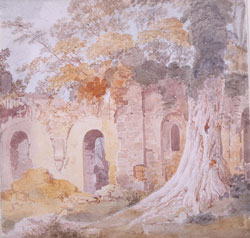 |
 |
 |
 |
 |
 |
 |
|
Kirkstall's monks after the Dissolution (2/5) What happened to the former monks of Kirkstall?
It has been calculated that the average age of the community was 43 years: most of the monks were aged between 40-49, three were over seventy and eight between 25-29.(1) At least two members of the community resided on property formerly belonging to the monastery: Abbot John, ‘a sober man who spoke little’, was said to have spent the remainder of his days in the gate-house of the abbey; Thomas Bartlett, a Leeds man, lived at Allerton Grange(2)until his death in 1542.(3) Two of Kirkstall’s vicarages, Aldbrough and Hollym in Holderness, may have been held by Thomas Ellis and John Lister, former monks of the abbey.(4) The community’s names appended to the surrender deed suggest that a number of the monks originally came from within a twenty-mile radius of the abbey, and it seems that the majority of them settled in the Leeds vicinity after the closure of their abbey.(5) For example, Anthony Jackson, former bursar of the abbey, served as curate of Horsforth and later of Otley; Thomas Bartlett, Richard Ellis and Edward Heptonstall (Pomfret) were priests of Leeds and Gabriel Lofthouse, one of the monks accused of sodomy in 1535-6 by Layton and Legh, was chaplain of Richmond and buried in the porch of the parish church there. Gabriel evidently led a rather frugal life for his will of 1552 lists his possessions as simply his bedding, a long gown, a wooden spoon tipped with silver and just over a guinea. In contrast, Thomas Pepper of Bramley seems to have enjoyed a life of relative comfort. Following the Dissolution, Pepper, a junior monk of the abbey, was rector of Adel. Although he received an annual pension of only £5 from the abbey, Pepper inherited his father’s lands at Bramley; his own purchases included Weetwood ironworks, which had belonged to Kirkstall and leased to Robert Neville sixteen months before the surrender of the abbey; they remained in Neville’s possession until 1542.(6) Pepper’s will of 1553 suggests that he had by this time accumulated a substantial fortune, for he left £86, ten gold angels, and forgave his debtors the £20 owing to him; he also had two men servants and three female servants.(7) |
